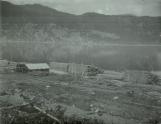1
Western Red cedar 7-36 meters (25-120 feet) long was the preferred species for making hydro-electric, telephone and flag poles because of its natural preservative. Pole companies hired men to supply the pole yards with wood however individuals and small contractors would also provide poles. In the bush, once a tree was fallen, a pole-maker used an axe to peel, and a peavey to turn the logs thus producing a pole. Peeled logs were often left in the bush to dry making them lighter for horses to skid out of the bush before transporting them to pole yards.4
Pole yards were holding stations generally located near the lake and a railroad siding. The poles were sorted to length, class and size before being shipped to treatment plants. Generally a pole yard would employ between 10-15 men with additional outside contractors hauling the poles to the pole yards.In the early years, horses and gin poles were used to load rail cars. In the later years, poles were loaded by front-end loaders and transported by trucks.




